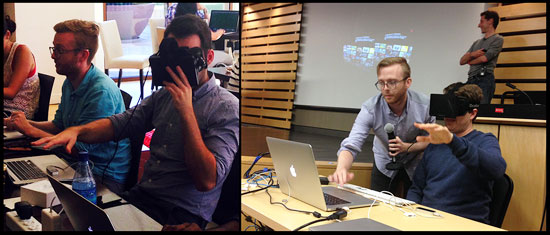A team of Netflix programmers merged the company’s videos with the virtual reality capability offered by the Oculus Rift headset as a fun project on Netflix Hack Day.
The Oculix media app lets users browse a floating 3D Netflix video catalog using head turning movements and hand gestures. Once a selection is made, the user can watch the video in a VR theater setting.
“This new user experience is potentially a very compelling differentiator for a mature [over-the-top] service such as Netflix as it seeks to stay on top of the market,” Eric Smith, an analyst at Strategy Analytics, told LinuxInsider.
However, it might not be suited for general use, because users can get disoriented.
“I can personally attest to disorientation after … five- to 10-minute sessions,” Smith said. “With TV shows and movies going beyond the one-hour mark, this would be my biggest concern.”
Motion sickness also could be an issue, Smith cautioned, although advances in VR technology are constantly mitigating that problem.
See Me… Feel Me…
Netflix “has not shied away from the cutting edge of technology, having been a pioneer in streaming exclusive content over broadband in the last decade and launching a 4K video service in 2014,” Smith remarked.
Being an early champion of new technology could further differentiate Netflix from its rivals, he added.
However, “while watching and interacting with video using VR could be really interesting, navigating through [a] large collection may not be any better or easier than using the traditional remote control,” suggested Brian Blau, a research director at Gartner.
“Given there are no VR devices in use in the consumer market, I don’t see Netflix doing this any time soon,” he said. “They will most likely wait to better understand how to build effective 3D user interfaces before they go off and make something that people can’t or won’t use.”
Hack Day “is blue sky for engineers. We have nothing to add beyond what’s in the videos,” Netflix spokesperson Jonathan Friedland told LinuxInsider.
Take Me to the Movies
“Given the immersiveness offered by VR, it just makes sense that having a more intimate experience with the content will change — and challenge — our perceptions,” Gartner’s Blau told LinuxInsider. “Movie makers and game developers want the opportunity to provide these new types of experiences and they can accomplish this through VR.”
Hollywood studios already are testing ways of implementing VR for watching movies, and Facebook’s acquisition of Oculus Rift “portends a social aspect,” Strategy Analytics’ Smith suggested, “such as VR chat rooms or VR calls.”
VR Got Game
From Sony, there likely will be “a mid-generation introduction of VR technology for the PlayStation 4 via its Project Morpheus development, and Microsoft could certainly harness its Kinect camera for VR gaming on Xbox One as well,” said Smith.
Virtual reality “has compelling use cases in many other markets [apart from games] … but won’t catch on until one important thing happens, and that is simply gaining experience in developing these immersive environments at a mass scale and then seeing how people use these devices and how they react,” said Blau.
We are still several years away from VR being a consumer product, in Smith’s view.
The Edge of Tomorrow
The future may already be here.
Cyberith has launched a Kickstarter project for the Virtualizer, which lets users move about while in virtual environments instead of sitting at a desk.
The virtualizer consists of a handheld console, a light headset, and a frame with an omnidirectional treadmill.
“Staring at a screen was not enough for me,” said Cyberith CEO Tuncay Cakmak, explaining why he came up with the idea.
“For us,” he remarked, “immersion is the most important thing in virtual reality.”






















































